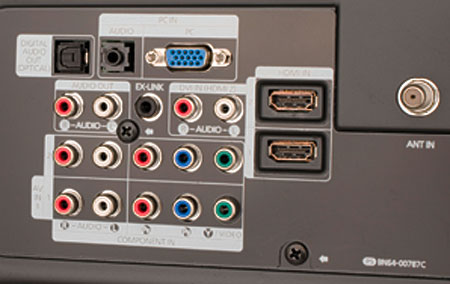Samsung PN50A550 Plasma TV Setup & Tests
Tom Norton reviewed the PN50A550 for Home Theater before I got my hands on it, so I'll let him tell you about setting it up:
With its latest sets, including this one, Samsung provides the most flexible setup controls I've seen. A new service menu offers far more detailed adjustments than usual, including the option to lock the controls so the user can't change them. But a full calibration can also be performed with the user-menu controls, which are the ones I used—together with the right test tools, of course. There's also a blue-only mode, which turns off the red and green colors and makes it possible to set the color and tint controls accurately without a blue filter.
But it's the Color Space control that really sets the Samsung apart. It offers three settings: Auto, Native, and Custom. Auto responds to the needs of the program material—the color-space standard is slightly different for HD and SD. The Native color space is wider than the standard, though no more so than on most new sets. You can use the Custom adjustments to accurately set both the primary (red, green, and blue) and secondary (yellow, cyan, and magenta) color points.

Other sets offer similar controls, but the Samsung's are the least frustrating I've yet used. As always, this process requires sophisticated test gear. The Color Space controls interact somewhat with the color-temperature calibration settings, so some back and forth is required to dial everything in precisely.
 With Just Scan mode engaged, 1080i/p sources show no overscan, which is as it should be. However, 720p signals lose three pixels on all four sides, while 480p signals are cropped by more than 10 pixels all around.
With Just Scan mode engaged, 1080i/p sources show no overscan, which is as it should be. However, 720p signals lose three pixels on all four sides, while 480p signals are cropped by more than 10 pixels all around.
This TV did not clip or "crush" whites even with the contrast turned all the way up to 100. As a result, achieving sufficient light output won't be a problem for all but the most ridiculous full-daylight viewing conditions. Blacks were very good to excellent for a plasma at this price point, resulting in an excellent contrast ratio and a pleasingly punchy picture.
Bandwidth with a 1080i signal via HDMI was solid at 37.1MHz, but the component video input was significantly rolled off, with little if any detail visible above 18.75MHz. You will definitely want to use an HDMI connection with this TV.
On the FPD Benchmark Blu-ray test disc, the moving monoscope pattern was tack sharp. Details were perfectly resolved out to 1080 lines, and characters looked sharp, even in motion. In fact, all the motion clips looked much better than on almost any LCD TV, and that includes the high-end models with a 120Hz refresh rate.
On the HQV Benchmark DVD at 480i via component, vertical detail was excellent, with horizontal detail only slightly less so. Jaggies were mild overall, and the waving flag looked particularly clean. The set's noise reduction was effective, quieting the image without overtly softening the picture. It can be left in the Medium or Auto position for most sources. On the 3:2 pulldown tests, the set locked on within a few frames. All the mixed-cadence tests were handled with aplomb, with no breakup or jaggies. Overall, the Samsung's video-processor performance was quite good.
Turning to the HQV Benchmark HD DVD at 1080i via HDMI, the video and film resolution-loss tests were both solid as a rock, and jaggies were practically invisible. The pan across the bleachers looked good, with only a small loss of detail when the image was in motion.
- Log in or register to post comments














































